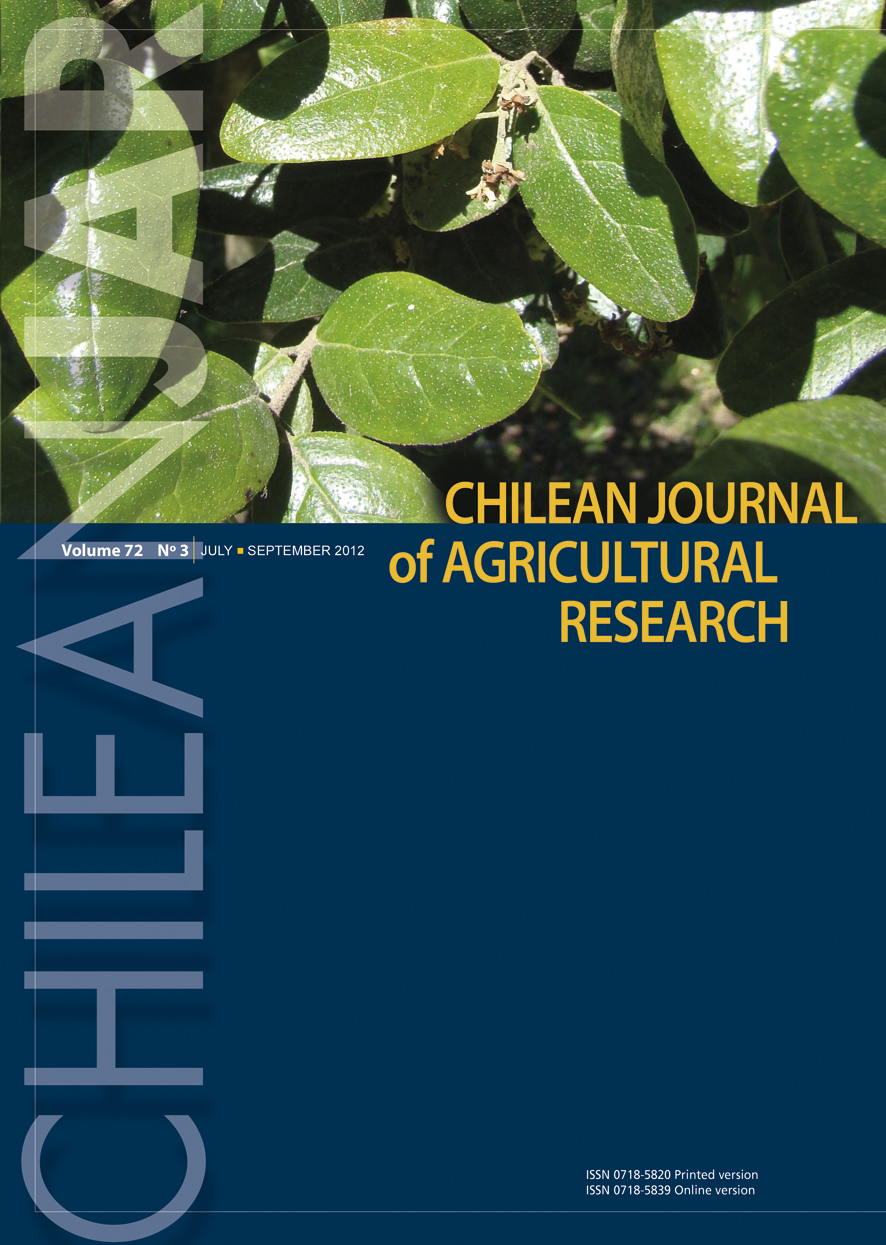
|
Chilean Journal of Agricultural Research
Instituto de Investigaciones Agropecuarias, INIA
ISSN: 0718-5820
EISSN: 0718-5820
Vol. 68, No. 2, 2008, pp. 146-155
|
 Bioline Code: cj08014
Bioline Code: cj08014
Full paper language: English
Document type: Research Article
Document available free of charge
|
|
|
Chilean Journal of Agricultural Research, Vol. 68, No. 2, 2008, pp. 146-155
| es |
Pérdidas de nitrógeno, fósforo y potasio de un sistema pastoril con distinta carga animal en un suelo volcánico.
Alfaro, Marta; Salazar, Francisco; Iraira, Sergio; Teuber, Nolberto; Villarroel, Dagoberto & Ramírez, Luis
Resumen
En Chile existe poca información sobre la pérdida de nutrientes en sistemas ganaderos. El experimento se efectuó entre el 2004 y el 2006. Se evaluaron dos cargas animales (3,5 y 5,0 terneros ha-1) bajo pastoreo rotativo con terneros Holstein Friesian sobre pradera permanente (67,5 kg N y 40 kg P ha-1 año-1). Para cuantificar las pérdidas por arrastre superficial (N, P, K), se instalaron tres lisímetros superficiales (5 x 5 m) por tratamiento. Las pérdidas de N y K por lixiviación se estimaron con cápsulas cerámicas. Las muestras de arrastre superficial y lixiviado se analizaron individualmente para N disponible y total, P reactivo (RP) y total, y K. El nitrógeno orgánico disuelto (DON) y el P orgánico (OP) se estimaron como la diferencia entre los valores totales y los disponibles. La carga animal no incrementó las pérdidas de N, P y K (P > 0,05). Las pérdidas por arrastre superficial fueron < 0,5 kg N, < 0,05 kg Py < 0,6 kg K ha-1 año-1, respectivamente, debido al escaso arrastre superficial medido. Las pérdidas de N por lixiviación fueron altas (11 a 71 kg ha-1 año-1) y las de K bajas (3 a 5 kg ha-1 año-1). El N en arrastre superficial se perdió principalmente como DON (50%). El N lixiviado se perdió principalmente como nitrato (70%). El P se perdió como RP (70%). Los resultados indican que cargas animales de 5,0 terneros ha-1 pueden utilizarse, pero debe evitarse la fertilización en períodos de lluvia con el fin de reducir pérdidas incidentales de nutrientes.
Palabras-clave
eutrofización, calidad de agua, pastoreo, Andisol, producción de carne.
|
| |
| en |
Nitrogen, Phosphorus and Potassium Losses in a Grazing System with Different Stocking Rates in a Volcanic Soil
Alfaro, Marta; Salazar, Francisco; Iraira, Sergio; Teuber, Nolberto; Villarroel, Dagoberto & Ramírez, Luis
Abstract
In Chile there is little information on nutrient losses in livestock systems. The experiment was carried out between 2004 and 2006. Two stocking rates (3.5 and 5.0 steers ha-1) were tested under rotational grazing with Black and White Friesian steers on a permanent pasture (67.5 kg N and 40 kg P ha-1 yr-1). To quantify surface runoff losses (N, P, K), three surface lysimeters (5 x 5 m) per treatment were established. N and K leaching losses were estimated with ceramic cups. Runoff and leachate samples were individually analyzed for available and total N, reactive (RP) and total P, and K. Dissolved organic N (DON) and organic P (OP) were estimated as the difference between total and available forms. The stocking rate did not increase total N, P and K losses (P > 0.05). Losses in surface runoff were < 0.5 kg N, < 0.05 kg Pand < 0.6 kg K ha-1 yr-1, respectively, due to the low amount of runoff measured. Nitrogen leaching losses were high (11 up to 71 kg ha-1 yr-1) and K leaching losses were low (3 to 5 kg ha-1 yr-1). Nitrogen in runoff was mainly lost as DON (50%). Nitrogen leaching losses were mainly as nitrate (70%). Phosphorus was lost as RP (70%). Thus, stocking rates of 5.0 steers ha-1 are plausible, but fertilizer application should be avoided in rainfall periods during the year to reduce incidental nutrient losses.
Keywords
eutrofication, water quality, grazing, Andisol, beef production.
|
| |
© Copyright 2008 - Instituto de Investigaciones Agropecuarias, INIA (Chile).
Alternative site location: http://www.inia.cl
|
|
